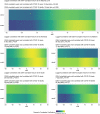COVID-19: US federal accountability for entry, spread, and inequities-lessons for the future
- PMID: 33136249
- PMCID: PMC7604229
- DOI: 10.1007/s10654-020-00689-2
COVID-19: US federal accountability for entry, spread, and inequities-lessons for the future
Abstract
The United States (US) has been among those nations most severely affected by the first-and subsequent-phases of the pandemic of COVID-19, the disease caused by SARS-CoV-2. With only 4% of the worldwide population, the US has seen about 22% of COVID-19 deaths. Despite formidable advantages in resources and expertise, presently the per capita mortality rate is over 585/million, respectively 2.4 and 5 times higher compared to Canada and Germany. As we enter Fall 2020, the US is enduring ongoing outbreaks across large regions of the country. Moreover, within the US, an early and persistent feature of the pandemic has been the disproportionate impact on populations already made vulnerable by racism and dangerous jobs, inadequate wages, and unaffordable housing, and this is true for both the headline public health threat and the additional disastrous economic impacts. In this article we assess the impact of missteps by the Federal Government in three specific areas: the introduction of the virus to the US and the establishment of community transmission; the lack of national COVID-19 workplace standards and enforcement, and lack of personal protective equipment (PPE) for workplaces as represented by complaints to the Occupational Safety and Health Administration (OSHA) which we find are correlated with deaths 16 days later (ρ = 0.83); and the total excess deaths in 2020 to date already total more than 230,000, while COVID-19 mortality rates exhibit severe-and rising-inequities in race/ethnicity, including among working age adults.
Keywords: Border control; COVID-19; Health inequities; Occupational health; Pandemic preparedness; Trump administration.
Conflict of interest statement
The authors declare that they have no conflict of interest.
Figures



Similar articles
-
Assessing COVID-19 pandemic policies and behaviours and their economic and educational trade-offs across US states from Jan 1, 2020, to July 31, 2022: an observational analysis.Lancet. 2023 Apr 22;401(10385):1341-1360. doi: 10.1016/S0140-6736(23)00461-0. Epub 2023 Mar 23. Lancet. 2023. PMID: 36966780 Free PMC article.
-
SARS-CoV-2 pandemic and Construction Industry: insights from Italian data.Acta Biomed. 2022 Jul 1;93(3):e2022233. doi: 10.23750/abm.v93i3.12265. Acta Biomed. 2022. PMID: 35775779 Free PMC article.
-
Dynamic Public Health Surveillance to Track and Mitigate the US COVID-19 Epidemic: Longitudinal Trend Analysis Study.J Med Internet Res. 2020 Dec 3;22(12):e24286. doi: 10.2196/24286. J Med Internet Res. 2020. PMID: 33216726 Free PMC article.
-
One Year of Coronavirus Disease 2019 (COVID-19) in Brazil: A Political and Social Overview.Ann Glob Health. 2021 May 18;87(1):44. doi: 10.5334/aogh.3182. Ann Glob Health. 2021. PMID: 34046307 Free PMC article. Review.
-
The use of personal protective equipment in endoscopy: what should the endoscopist wear during a pandemic?Expert Rev Gastroenterol Hepatol. 2021 Dec;15(12):1349-1359. doi: 10.1080/17474124.2021.2011213. Epub 2021 Dec 20. Expert Rev Gastroenterol Hepatol. 2021. PMID: 34821190 Review.
Cited by
-
Modeling the impact of racial and ethnic disparities on COVID-19 epidemic dynamics.Elife. 2021 May 18;10:e66601. doi: 10.7554/eLife.66601. Elife. 2021. PMID: 34003112 Free PMC article.
-
Spatiotemporal Associations Between Social Vulnerability, Environmental Measurements, and COVID-19 in the Conterminous United States.Geohealth. 2021 Aug 4;5(8):e2021GH000423. doi: 10.1029/2021GH000423. eCollection 2021 Aug. Geohealth. 2021. PMID: 34377879 Free PMC article.
-
The evolving roles of US political partisanship and social vulnerability in the COVID-19 pandemic from February 2020-February 2021.PLOS Glob Public Health. 2022 Dec 5;2(12):e0000557. doi: 10.1371/journal.pgph.0000557. eCollection 2022. PLOS Glob Public Health. 2022. PMID: 36962752 Free PMC article.
-
"Freedom to Breathe": Youth Participatory Action Research (YPAR) to Investigate Air Pollution Inequities in Richmond, CA.Int J Environ Res Public Health. 2021 Jan 11;18(2):554. doi: 10.3390/ijerph18020554. Int J Environ Res Public Health. 2021. PMID: 33440892 Free PMC article.
-
African Americans and the COVID-19 pandemic: A qualitative inquiry of preparedness, challenges, and strategies on how we can move forward.Soc Sci Med. 2022 Aug;307:115185. doi: 10.1016/j.socscimed.2022.115185. Epub 2022 Jun 30. Soc Sci Med. 2022. PMID: 35793594 Free PMC article.
References
-
- Schiffman A. nCoV2019.live website. 2020. https://ncov2019.live/data.
-
- Worldometer—Coronavirus, “Reported Cases and Deaths by Country, Territory, or Conveyance.” 2020. https://www.worldometers.info/coronavirus/#countries.
-
- Blow C. The racial time bomb in the Covid-19 Crisis. New York Times 2020 April 1. https://www.nytimes.com/2020/04/01/opinion/coronavirus-black-people.html.
-
- Kendi IX. What the data show: the pandemic seems to be hitting people of color the hardest. The Atlantic 2020 April 6. https://www.theatlantic.com/ideas/archive/2020/04/coronavirus-exposing-o....
-
- Bailey Z, Barber S, Robinson W, et al. Racism in the time of COVID-19. Interdisciplinary Association for Population Health Science 2020 April 9. https://iaphs.org/racism-in-the-time-of-covid-19/.
Publication types
MeSH terms
Grants and funding
LinkOut - more resources
Full Text Sources
Medical
Research Materials
Miscellaneous

